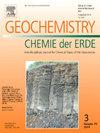Geochemical signature of hydrothermal alteration in surface rocks of Cerritos Colorados geothermal field of Mexico
IF 2.9
3区 地球科学
Q2 GEOCHEMISTRY & GEOPHYSICS
引用次数: 0
Abstract
Several reliable and extensively applied traditional geochemical, mineralogical, and petrography methods exist for identifying hydrothermal alteration of rocks. However, many of these methods require tedious and laborious sample preparation and analysis procedures. Therefore, there is a need for faster methods and reliable in their application. Binary diagrams of felsic vs mafic components, Na2O content, porosity, and permeability of the rocks are newer methods that are faster in their application and more reliable and have the potential to be considered for this purpose. These methods are successfully applied to the surface rocks of Cerritos Colorados Geothermal Field (CCGF) providing consistent results that are comparable to those obtained by extensively applied and highly reliable mineralogical and geochemical methods. Most of these altered rocks are from the formation of the Post-Tala Quaternary Lacustrine Sediments and are located near the faults and fumaroles. Evaluation of the results obtained by all applied methods confirms that the new methods are easy to measure and reliable, which can be useful as additional tools during the initial stage of geothermal exploration in identifying altered rocks and zones of hydrothermal alteration. Mass change values reveal the highest mobility for the major elements and the lowest mobility for the trace elements in the rocks of the study area.
墨西哥Cerritos Colorados地热田地表岩石热液蚀变地球化学特征
传统的地球化学、矿物学和岩石学方法在识别岩石热液蚀变方面有几种可靠且应用广泛的方法。然而,许多这些方法需要繁琐和费力的样品制备和分析程序。因此,需要更快的方法和可靠的应用。长英质与基性组分、Na2O含量、孔隙度和渗透率的二元图是一种更新的方法,应用速度更快,更可靠,有可能被考虑用于这一目的。这些方法成功地应用于Cerritos Colorados地热田(CCGF)的地表岩石,提供了与广泛应用且高度可靠的矿物学和地球化学方法相媲美的一致结果。这些蚀变岩大多来自后塔拉第四纪湖相沉积,位于断裂和喷气孔附近。结果表明,新方法测量简便、可靠,可作为地热勘探初期识别蚀变岩和热液蚀变带的辅助工具。质量变化值揭示了研究区岩石中主元素迁移率最高,微量元素迁移率最低。
本文章由计算机程序翻译,如有差异,请以英文原文为准。
求助全文
约1分钟内获得全文
求助全文
来源期刊

Chemie Der Erde-Geochemistry
地学-地球化学与地球物理
CiteScore
7.10
自引率
0.00%
发文量
40
审稿时长
3.0 months
期刊介绍:
GEOCHEMISTRY was founded as Chemie der Erde 1914 in Jena, and, hence, is one of the oldest journals for geochemistry-related topics.
GEOCHEMISTRY (formerly Chemie der Erde / Geochemistry) publishes original research papers, short communications, reviews of selected topics, and high-class invited review articles addressed at broad geosciences audience. Publications dealing with interdisciplinary questions are particularly welcome. Young scientists are especially encouraged to submit their work. Contributions will be published exclusively in English. The journal, through very personalized consultation and its worldwide distribution, offers entry into the world of international scientific communication, and promotes interdisciplinary discussion on chemical problems in a broad spectrum of geosciences.
The following topics are covered by the expertise of the members of the editorial board (see below):
-cosmochemistry, meteoritics-
igneous, metamorphic, and sedimentary petrology-
volcanology-
low & high temperature geochemistry-
experimental - theoretical - field related studies-
mineralogy - crystallography-
environmental geosciences-
archaeometry
 求助内容:
求助内容: 应助结果提醒方式:
应助结果提醒方式:


